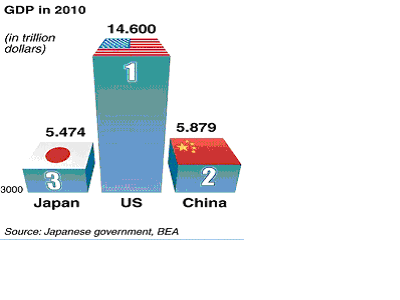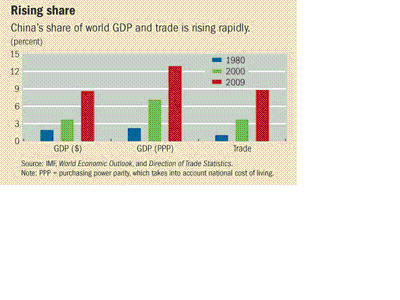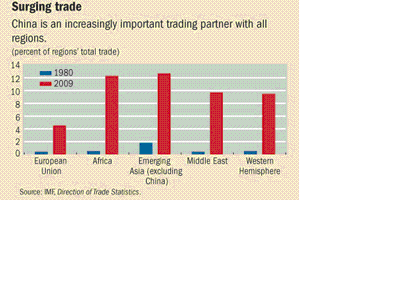By Mehmood-Ul-Hassan Khan
According to recent official figures of the Japanese government and the IMF (2011), China has surpassed Japan and succeeded to become world second largest economy after the US. The country of 1.4 billion souls has achieved it after three decades of spectacular socio-economic growth. During this period despite global economics recessions and financial crunches, China’s economy stood firm, stable and sustainable.
The above diagram clearly verifies that China has been eclipsing Japan economically and now its GDP stand at US$5.879 trillion which is grater than Japan’s GDP US$5.474 trillion. Many international economists around the globe are forecasting that China will pass the United States as the world’s biggest economy as early as 2030. America’s gross domestic product was about $14 trillion in 2009.
In recent years, China has started to reshape the existing global economic order and system by virtue of its growing dominance of international trade, its huge deposits of foreign exchange reserves and United States government debt and its voracious appetite for oil, coal, iron ore and other natural resources.
The above given diagram indicates China’s leading trade partnership with many countries around the globe. China is already a major driver of global growth. China the new economic superpower has begun to assert greater influence in Asia, Africa and Latin America by promoting bilateral trade, investments and joint ventures of multibillion dollars.
Beijing has also determination to shape global dialogues on a range of issues and it asserts that the dollar must be phased out as the world’s primary reserve currency. And while the United States and the European Union are struggling to grow in the wake of the worst economic crisis in decades, China has continued to climb up the economic league tables by investing heavily in infrastructure and backing a $586 billion stimulus plan in 2009-2010. According to the latest data of the World Bank (January, 2011), China’s economy is forecast to expand about 10 percent in 2011 continuing a remarkable three-decade streak of double-digit growth.
According to the Washington-based institute for international economics in terms of purchasing power, China overtook the U.S. as the world’s largest economy in 2010. It further elaborated that in purchasing power parity (PPP) terms the size of China’s economy was U.S. $14.8 trillion in 2010, compared to the U.S. economy’s $14.6 trillion. It is now the world’s biggest auto market and the largest energy consumer.
New Chinese model of economic growth
During the recent time of global economic and financial crises the government of China introduced new economic growth model due to which it has succeeded to mitigate the bad effects of ongoing global economic recession on its macro-economy.
(a) Role of the state, concentrates much more on increasing domestic demand for the products of the expanding industrial base.
(b) Relies on building trading ties with the countries in its immediate neighborhood.
(c) Paradigm shift in structure of the economy.
(d) Mega projects of urbanization in order to discourage migration process
(e) Exports-oriented policies and mechanism
(f) Equitable exchange rate management
(g) High levels of domestic savings invested in United States Treasuries.
(h) Active participation of private sector
(i) Renewal of agricultural sector especially in western provinces such as Xinjiang and Gansu.
Vast opportunities for Pakistan
Pakistan and China have jointly declared 2011 as “Pak-China friendship year” in recognition of 60 years of exemplary, all-weather friendship that has stood the test of time. Being the second largest economy of the world offers vast opportunities for the government and private sector in the country in the fields of energy, construction, agriculture and science and technology etc. China has already become the second leading economic partner of Pakistan and its entrepreneurs are making huge investments in the country. The Chashma power plants, heavy mechanical and electrical complexes and Gwadar deep sea port are the prime examples of Chinese huge investments in Pakistan.
During the recent visit of Chinese Prime Minister Wen Jiabao both countries signed 17 agreements, four MoUs and one joint venture worth $15 billion for investment in various sectors of the economy. Moreover, both the countries agreed to initiate a new 5 year development plan.
The public-private sector of Pakistan is keen to extend ties with Chinese firms in the field of energy in order to overcome its severe energy shortage. Many Chinese companies such as Harbin Power Engineering Company Ltd., Dongfang Electric Corp., CWE, Sinohydro Corp., Zhongyuan Engineering Group, Gezhouba Group, CMEC, and CMC are working in the energy sector of Pakistan. Chinese private companies are engaged with 40 projects amounting $5 billion of hydropower, thermal power, nuclear power, and electricity transmission and transformation. Chashma Nuclear Power Plant II and the Neelum-Jhelum Hydropower Station and the Sardhi wind power project are the prime examples of extended Pak-China energy cooperation. Remarkably, a project of $6.5 billion generating 2,300MW of electricity through wind turbines and solar panels was also recently signed.
The bilateral trade between the two countries was $6.8 billion in 2008, which was higher by 30 per cent as compared to the 2007. Bilateral trade volume in the first five months of 2010 increased by 31 percent and Pakistan’s exports to China grew by 72 percent, as compared to the same period 2009. It is expected that trade between Pakistan and China is likely to surge to $18 billion in the next 5 years.
Table-1 ($US million)
Year Exports Imports
2001-01 228.63 575.37
2002-03 244.59 839.00
2003-04 288.259 1,153.514
2004-05 354.092 1,842.270
2005-06 463.967 2,706.159
2006-07 575.903 3,533.794
2007-08 684.739 4691.813
Source: Federal board of statistics and WTO (2009).
Table-II: Major Pakistan’s exports (commodities) to China
($US million)
Commodities 2003-04 2004-05 2005-06 2006-07 2007-08
Cotton yarn & woven fabrics 157.358 206.767 213.133 379.219 352.867
Organic chemicals 33.427 8.487 37.718 19.911 24.71
Leather & leather manufacturers 15.08 14.55 28.132 31.639 39.27
Ores, slag, ash 3.641 9.909 25.615 22.092 27.42
Fish and its products 18.659 19.604 22.252 29.767 34.94
Source: Federal board of statistics and WTO (2009).
The above table shows that mix of Pakistani exports to China is confined only to few items which should be increased in the future.
Major Pakistan’s imports (commodities) China
Table-III ($US million)
Commodities 2003-04 2004-05 2005-06 2006-07 2007-08
Boiler machinery & appliances 161.208 257.74 483.87 618.937 808.22
Electrical appliances & parts 114.668 171.332 327.49 449.72 587.25
Organic chemicals 62.03 77.838 104.672 128.508 167.81
Petroleum products & oil 6.47 22.96 66.83 97.596 127.428
Misc. products 44.458 74.50 81.773 75.735 98.89
Source: Federal board of statistics and WTO (2009).
Pakistan needs to extend bilateral ties in the fields of agriculture, seafood, basic raw materials, coal and marble. It must set up joint ventures with Chinese private companies with buy-back arrangements due to which our labours can learn Chinese technology, increase productivity as well increase yield per acre, and export backed arrangements with China will help us to further increase its exports to China.
Expected cooperation
Sectors
Defence production, Reko-Diq Copper Mining project in Balochistan, energy generation, technology development, industrial base and software park building and communications infrastructure to promote ICT sector, including e-government, e-commerce and e-enterprise.
According to the central bank of China (January, 2011) rose by $199 billion to $2.85 trillion, the biggest quarterly gain since 1996. Pakistan and China agreed to start currency swap which could be win-win situation for both the countries.
Concluding Remarks
Pakistan and China are strategic friends and now being the second largest economy of the world prospects are very bright to further strengthening of bilateral trade relations between the two countries in the days to come. The government of Pakistan must protect the Chinese interests as well as investments in the country. Joint ventures with China hold the key of success for Pakistan.


